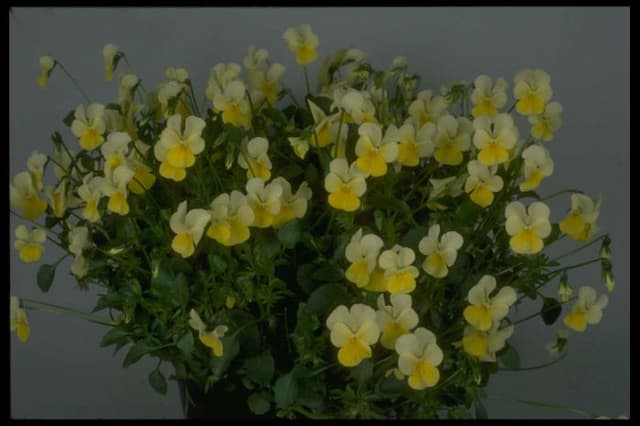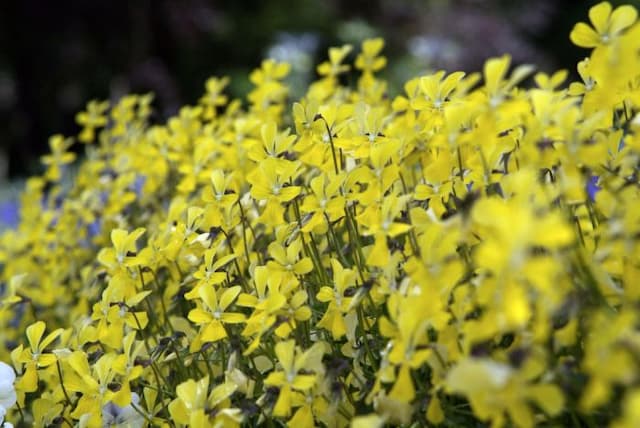Pansy Viola 'Juliette Blue, Pale Wings'

ABOUT
Viola 'Juliette Blue, Pale Wings' is a charming flowering plant that exhibits a distinctive and captivating appearance. The focal point of this viola is its delicate blossoms, which are characterized by a beautiful contrast of colors. The flowers typically showcase a deep and rich blue hue at the center, which gracefully fades to a gentle pale color towards the edges of the petals, creating the impression of wings – hence the name 'Pale Wings'. The petals are often rounded with a slight ruffle at the margins, adding to the softness of its aesthetic. Surrounding the flower, the foliage forms a lush backdrop of greenery. The leaves are generally heart-shaped or ovate, with fine veins visibly threading throughout the leaf structure. They provide a perfect contrast to the romantic coloration of the blooms, which may appear as solo ornaments perched atop slender, yet sturdy stems or clustered together in a delightful show of color and form. This viola's flowering period adds to the visual appeal, with its ability to produce an abundance of blooms that can enliven a space with their subtle yet eye-catching allure. The overall visual impact of Viola 'Juliette Blue, Pale Wings' is that of an enchanting, small flowering plant that can easily fit into garden nooks, borders, or containers, where its blossoms will stand out and capture the attention and admiration of onlookers.
About this plant
 Names
NamesSynonyms
Johnny Jump Up, Heartsease, Pansy, Viola.
Common names
Viola 'Juliette Blue, Pale Wings'.
 Toxicity
ToxicityTo humans
Garden pansies, including the variety Viola 'Juliette Blue, Pale Wings', are generally considered non-toxic to humans. Ingesting parts of the plant typically does not cause poisoning or adverse symptoms. However, it is always advisable to avoid eating ornamental plants due to potential pesticide exposure and the possibility of individual allergic reactions.
To pets
Garden pansies, including the variety Viola 'Juliette Blue, Pale Wings', are also generally considered non-toxic to pets. Ingesting parts of the plant is not likely to cause poisoning or severe symptoms in pets. As with humans, the primary concern would be any pesticides used on the plant or possible individual allergic reactions that could occur.
 Characteristics
CharacteristicsLife cycle
Perennials
Foliage type
Evergreen
Color of leaves
Green
Flower color
Blue
Height
6 inches (15 cm)
Spread
6 inches (15 cm)
Plant type
Herb
Hardiness zones
5
Native area
Europe
Benefits
 General Benefits
General Benefits- Enhances Garden Aesthetics: Violas, including the 'Juliette Blue, Pale Wings' variety, add a delicate touch of color and beauty to gardens and landscapes.
- Extended Blooming Season: Violas are known for their lengthy blooming cycle, which can extend from spring through fall, offering prolonged visual interest.
- Attracts Pollinators: These flowers can attract bees and butterflies, which are important for pollination and maintaining a healthy ecosystem.
- Low Maintenance: They are relatively easy to care for, requiring minimal upkeep, which makes them suitable for gardeners of all levels.
- Versatile Planting: Violas can be planted in garden beds, borders, containers, and hanging baskets, offering versatility in landscape design.
- Cold Tolerance: They are capable of withstanding cooler temperatures, making them suitable for early spring and late fall planting in many climate zones.
- Edible Flowers: Viola flowers are edible and can be used to garnish salads, desserts, and drinks, adding a touch of elegance to culinary presentations.
- Ground Cover: Their dense growth habit can create a beautiful ground cover, reducing weed growth and soil erosion.
- Color Variety: Violas come in a wide array of colors and patterns, providing many options for color coordination and thematic garden designs.
 Medical Properties
Medical PropertiesThis plant is not used for medical purposes.
 Air-purifying Qualities
Air-purifying QualitiesThis plant is not specifically known for air purifying qualities.
 Other Uses
Other Uses- Perfume Industry: The delicate scent of violets can be captured and used as a natural fragrance in perfumes, providing a subtle floral note.
- Edible Decorations: The flowers of the viola can be candied or used fresh to adorn cakes, desserts, or as a garnish in gourmet dishes for a touch of elegance.
- Natural Dyes: Both the petals and leaves can be used to produce natural dyes for fabric or food colouring, yielding shades of green and yellow to purple.
- Floral Ice Cubes: Freeze viola flowers inside ice cubes to create visually stunning additions for punch bowls and cocktails.
- Aromatherapy: Dried viola flowers can be included in potpourri or sachets to promote a calming environment with their gentle fragrance.
- Fairy Gardens: Violas are perfect for creating miniature gardens or fairy landscapes due to their small size and enchanting appearance.
- Culinary Oil Infusions: Infuse oils with the essence of viola flowers to create unique, flavored oils for cooking or salad dressings.
- Artistic Inspiration: The delicate and vibrant appearance of violas make them an ideal subject for botanical illustrations and watercolor paintings.
- Seasonal Floats: Incorporate violas in spring-themed floats for parades or decorative boats in garden ponds.
- Traditional Crafts: Pressed viola flowers can be used in scrapbooking, card making, or in traditional pressed flower crafts, adding natural beauty to handmade items.
Interesting Facts
 Feng Shui
Feng ShuiThe pansy is not used in Feng Shui practice.
 Zodiac Sign Compitability
Zodiac Sign CompitabilityThe pansy is not used in astrology practice.
 Plant Symbolism
Plant Symbolism- Innocence: Violas commonly symbolize innocence due to their delicate and unassuming appearance.
- Love: As a member of the violet family, violas are often associated with love and affection, particularly young love.
- Spirituality: Their gentle nature and habit of blooming in the shade lend them a spiritual symbolism, often associated with contemplation and spiritual thoughts.
- Humility: Violas grow close to the ground, which has traditionally been seen as a symbol of modesty and humility.
- Healing: Historically, violas were used in various medicinal concoctions, giving them a symbolic connection to healing and health.
 Water
WaterPansies like Viola 'Juliette Blue, Pale Wings' require consistent moisture but dislike waterlogged soil, so it's best to water them when the top inch of soil feels dry to the touch. Typically, this means watering once or twice a week, but this can vary depending on the climate, the season, and the weather conditions. Use about 16 ounces of water per square foot of soil each week during dry conditions. During rainy periods, reduce watering to prevent over-saturating the soil.
 Light
LightPansies thrive in full to partial sunlight, so Viola 'Juliette Blue, Pale Wings' will do best in a spot that gets at least 6 hours of direct sunlight each day. They can tolerate some shade, especially in hot climates where afternoon shade can help protect the plants from intense heat. However, too much shade can lead to leggy growth and fewer flowers.
 Temperature
TemperaturePansies, including Viola 'Juliette Blue, Pale Wings', are cool-season flowers that prefer temperatures between 40 and 60 degrees Fahrenheit. They can tolerate cold snaps down to about 20 degrees Fahrenheit but can be damaged by prolonged periods of freezing temperatures. The ideal temperature for lush growth and vibrant blooms typically ranges from 40 to 60 degrees Fahrenheit.
 Pruning
PruningPansies benefit from regular deadheading, which is the removal of faded or dead flowers, to encourage continuous blooming. For Viola 'Juliette Blue, Pale Wings', pinch off the spent blooms at the base of the flower stem. Prune them back by about one-third in midseason if the plants become leggy or overgrown. The best time to prune for shape and size is in the late fall or early spring.
 Cleaning
CleaningAs needed
 Soil
SoilViolas prefer well-draining soil with a rich composition of organic matter, such as a mix of peat, loam, and perlite or sand. An optimal pH for the Pansy 'Juliette Blue, Pale Wings' would be slightly acidic to neutral, ranging from 6.0 to 7.0.
 Repotting
RepottingPansies, including the variety 'Juliette Blue, Pale Wings', generally do not require frequent repotting and can be repotted every 1-2 years or when they outgrow their current container.
 Humidity & Misting
Humidity & MistingPansies like 'Juliette Blue, Pale Wings' prefer moderate to slightly higher humidity levels but are quite adaptable and can thrive in average household humidity conditions.
 Suitable locations
Suitable locationsIndoor
Keep in bright, indirect light and in cool conditions.
Outdoor
Plant in partial shade, ensure well-draining soil.
Hardiness zone
4-8 USDA
 Life cycle
Life cycleThe life of Viola 'Juliette Blue, Pale Wings', commonly referred to as Violet, begins with seed germination, typically in late winter to early spring, when temperatures are mild. After germination, seedlings establish a rosette of leaves close to the soil surface. As the plant matures, it develops its recognizable heart-shaped leaves and begins to produce distinctive flowers with a combination of deep blue and pale colors, usually in the cool temperatures of spring and fall. Following pollination, typically by insects, the plant sets seed in small capsules that are later dispersed by various means, including wind or animal movement. Throughout the growing seasons, Violets may also reproduce vegetatively through stolons, leading to the creation of new plants near the mother plant. Finally, as winter approaches, the plant will go dormant, with the cycle beginning anew the following spring.
 Propogation
PropogationPropogation time
Spring-Early Summer
The Viola 'Juliette Blue, Pale Wings', commonly known as a type of pansy, is best propagated through seed sowing. The ideal time to sow pansy seeds is late winter to early spring for flowering in the upcoming season, or during late summer for blooms in the fall and the following spring. To propagate by seed, begin by filling a flat or tray with seed-starting mix and lightly press the seeds into the soil surface, as pansy seeds need light to germinate. Cover the tray with plastic to maintain humidity and place it in a warm spot with temperatures around 65 to 75 degrees Fahrenheit (18 to 24 degrees Celsius). Keep the soil moist but not waterlogged. Germination typically occurs within 10 to 20 days. Once seedlings have developed their first true leaves, they can be transplanted into individual pots or into the garden at a spacing of about 6 to 8 inches (15 to 20 centimeters) apart.









